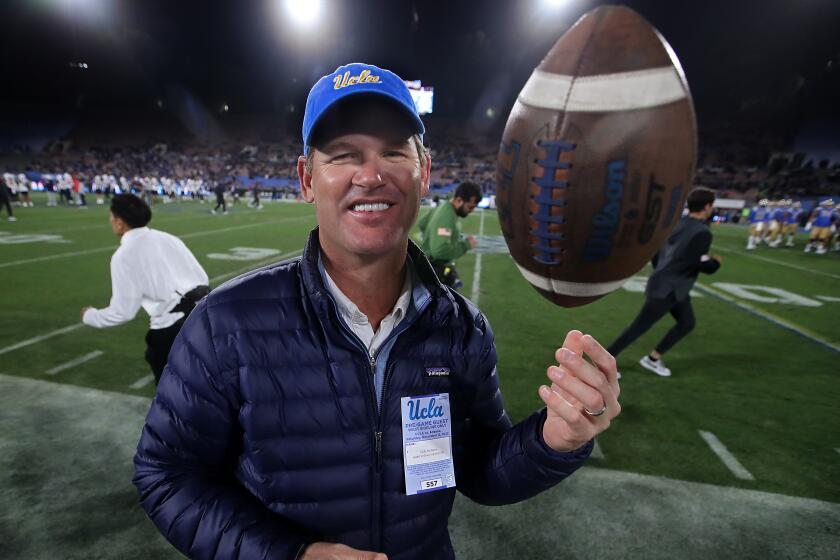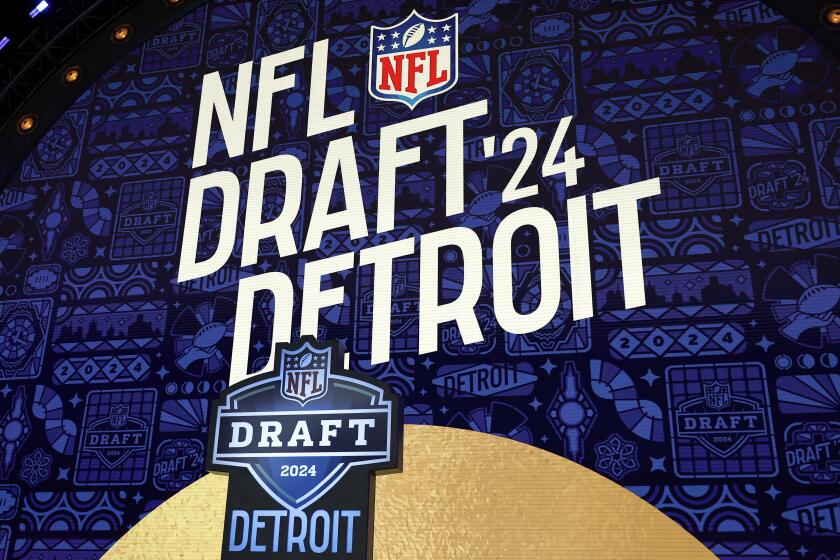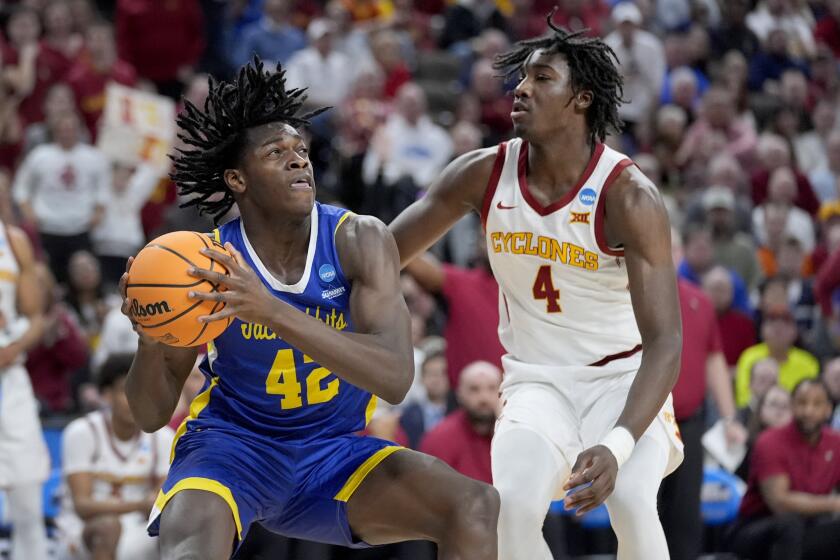Is Time Up for Pauley?
It’s old and dusty, and when it rains sewage sometimes backs up. There are no plasma screen TVs or elaborate stereo systems in the locker rooms. The food court is outside.
The men’s and women’s basketball teams juggle practice times with the men’s volleyball team, and there are cavernous spaces between the basket and the bleachers because a certain coach thought it was unsporting to have raucous fans too close to the court.
Though Pauley Pavilion, now in its 40th season, has 11 championship banners hanging from the ceiling -- and a singular 94-year-old legend named John Wooden who sits straight-backed and politely quiet in the stands -- the aging arena’s flaws have become difficult for many to ignore, especially at a time when local and national rivals are building modern on-campus arenas.
On the recruiting circuit, UCLA coaches hear from teenagers about Pauley’s shortcomings. Former stars are protective of its aura of history, though some acknowledge that its charms have faded. And whether it is because of the building or the team that occupies it, fans have tempered their Wooden-era fervor. Still, renovation efforts have been slow to gain traction.
“It’s all about the newest thing with kids,” said Ed O’Bannon, one of the stars of the 1995 team, the most recent of UCLA’s 11 national champions. “I compare Pauley Pavilion with Madison Square Garden or Boston Garden. It’s a little bit of a mecca. You want to say you played at Pauley Pavilion. But do you want to play there every day? I don’t know.”
USC freshman Gabe Pruitt holds the opinion of many young players. When asked whether Pauley’s luster was fading, Pruitt said: “I think so. I don’t have that feeling; it’s just another arena to me. Pauley is Pauley. It was never this holy place for me.”
As late as Wednesday afternoon, tickets were still available for Thursday’s game against USC -- an important one for the Bruins, who are barely hanging on to the chance for an NCAA tournament at-large bid. UCLA has sold out only one game at Pauley this season, against Arizona.
Over the last five years, Pac-10 rival Stanford spent $26 million to renovate Maples Pavilion and Washington spent $40 million to renovate Hec Edmundson Pavilion, renaming it Bank of America Arena. Cal tore down Harmon Gym and built Haas Pavilion for $57.5 million. Walter Haas, a former president of Levi Strauss and Co., donated the first $11 million. Oregon has recently spent about $4 million purchasing a bakery near campus in hopes of raising money to replace 80-year-old McArthur Court.
And USC, for several decades the bridesmaid to UCLA in basketball, has begun construction of a $114-million home to escape the musty Sports Arena. Around the country in recent years, large public universities such as Wisconsin and Ohio State have built arenas, while smaller private schools such as Gonzaga and Xavier have raised the money for similar projects. Three years ago, Pittsburgh opened a 12,500-seat court next to a new auxiliary gym, which provides extra practice facilities. The state of Pennsylvania contributed $53 million of the $96-million budget.
“Having the extra practice facilities was great, and kids were really excited about that,” said UCLA Coach Ben Howland, who was Pittsburgh’s coach at the time. “It is really a beautiful place.”
When USC’s Galen Center opens in 2006, it will leave Pauley in the bottom half of the conference in terms of modern enhancements with the likes of Washington State, Oregon State and Arizona State -- programs that haven’t mattered much in years.
“State-of-the-art type facilities are a recruiting tool, definitely,” Fairfax High Coach Harvey Kitani said. “Tradition should still matter too, but it seems as if UCLA should have one of the top places in the Pac-10.”
Kitani coached UCLA freshman Josh Shipp and now has 6-foot-7 senior Jamal Boykin, who has committed to play at Duke next year.
“I grew up my whole life rooting for UCLA and Duke,” Boykin said. “I’ve played games at Pauley and I can’t count how many times I’ve watched UCLA games at Pauley and here’s what I think: It’s not the building. It’s the program. If you’re winning, it doesn’t matter where you play.”
Boykin, who said he was not recruited by UCLA, fell in love with Duke partly because of the intense atmosphere inside 65-year-old Cameron Indoor Stadium, which is considered one of the best home-court atmospheres in the country.
“Cameron’s not new or fancy,” Boykin said, “and it’s just great.”
But Cameron is not the same place that opened in 1940. In 1987 the concourses and lobbies were renovated. In 1988 a new scoreboard, sound system and wood paneling updated the gym. At the end of the 1997-98 season an adjacent athletic center with new locker rooms, coaches’ offices, academic center and Hall of Fame was added.
“The new stuff is great too,” Boykin said. “Everybody likes all the newest bells and whistles, no doubt about that.”
Still, Cameron Indoor doesn’t look like much until the students known as “Cameron Crazies” pack the place. Similarly, Kentucky’s Rupp Arena is a middle-aged concrete circle until it is packed with blue-clad Wildcat fanatics -- and Ashley Judd. And no one seems to complain about Kansas’ 50-year-old Allen Fieldhouse.
To those who say Pauley needs major changes, Bill Walton says “balderdash.”
Walton, who played for Wooden at Pauley from 1972 to ‘74, calls Pauley “a mecca, a palace, a temple. What are the three lessons of life? Never whine, never complain, never make excuses.
“What’s wrong with Pauley? Nothing that good teams won’t change. I’ve generally found that good players and good coaching guarantee a good atmosphere. There is no place on earth like Pauley Pavilion because of those championship banners. It’s like the Boston Garden. Everybody complained about the old locker rooms and bathrooms, but everybody wanted to play at Boston Garden.”
When Walton was reminded the old Garden is gone, razed to build a fancy, new place, Walton muttered, “And how many championships have the Celtics won in the new place?”
The answer is none.
Damon Farmar, the father of UCLA freshman point guard Jordan Farmar, remembers that when he was growing up Pauley was a magnet for young basketball fans.
“I had to sneak in,” Damon Farmar, 42, said. “I’d sneak past the ushers, like sneaking into the movies, it was sold out every game, the atmosphere was so great.
“It’s not like that now. I’ve seen crowds very enthusiastic, but then I’ve gone to places like Michigan State and Oregon and seen really great atmospheres. Honestly, kids today have no clue about the history of Pauley. Jordan made a visit to Florida where everything was brand-new, state of the art, and he came home totally mesmerized by the facilities. But then he got home and realized Los Angeles was where he wanted to be.”
There have been whispers and tentative plans about expanding or renovating Pauley for more than a decade. There have been discussions about adding skyboxes, plans drawn for adding new locker rooms and meeting rooms and expanding and modernizing concession stands and restrooms.
But “nothing is imminent,” Howland said.
Athletic Director Dan Guerrero calls Pauley “hallowed ground,” but says changes are needed.
“Pauley does need a face-lift after 40 years,” he said. “In fact, we’ve been looking at a Pauley renovation for about a year now. We have met with an architect.”
Guerrero called it “a challenge” to plan a renovation that “maintains Pauley’s tradition and add 21st century amenities.” Improving concession stands, restrooms and circulation paths for fans while giving the basketball team new locker rooms, media rooms and a shooting court are priorities, he said.
“We’d also want to re-center the court,” he said, “to bring the seats closer to the floor and create a greater atmosphere. Our project would not be dissimilar to what was done with Haas Pavilion.”
There is no firm timeline, though. Guerrero said his hope is that by the end of this academic year “the scope of the project would be clearly identified,” after which a price tag would be put on the plans and fundraising could begin.
When Lynn Shackelford, a highly regarded star at Burbank’s Burroughs High, was being recruited by UCLA in 1964, Wooden and his staff tantalized him with stories about a magical place being built in the middle of the picture-perfect Westwood campus. It would seat more than 12,000 and offer the newest and best of everything -- lockers, showers, shiny bleachers, atmosphere. He received updated plans and pictures of the construction of Pauley Pavilion throughout his senior year at Burroughs.
“You know, I don’t think I was ever allowed to one practice at UCLA,” Shackelford said. “I don’t think Coach Wooden wanted me to see the old practice gym. He just wanted me to know about Pauley. Coach Wooden said, ‘Lynn, you’ll have your own court as a freshman, 3:30 to 5:30 to practice as a freshman. You’ll have your own varsity court, own locker room, you won’t have to share.’ So that’s how UCLA recruited me, with Pauley.”
In the first basketball game played at Pauley, the freshman team, with Shackelford and a classmate then known as Lew Alcindor, beat the varsity.
“It was packed and it was a real event,” said Shackelford, 57. “Is it the same now? I guess not. I guess I don’t know what 17-year-olds want. I remember back in the 1980s I was working as an NCAA tournament announcer at Pauley. It was a March day, 80 degrees, and a Seton Hall assistant coach looks around at all the national-championship banners, his team is staying in Century City and he says to me, ‘They have trouble recruiting here?’ When you look at it like that, you have to say, what’s wrong with Pauley?”
*
Times staff writer Paul Gutierrez contributed to this report.
*
(BEGIN TEXT OF INFOBOX)
Pauley Facts
* The start: Introduced to the university at the June 1965 commencement exercises, at which time it was dedicated and named for Regent Edwin W. Pauley, the principal donor to the building fund.
* Men’s basketball record: 546-84
* National championships: 9
* Capacity: 12,819
* Largest crowd: 13,478, vs. Duke, Feb. 23, 1997
* Average attendance: 10,627
* The court: On Dec. 20, 2003, the floor was dedicated “Nell and John Wooden Court.”
*--* AVERAGE ATTENDANCE The average crowd at Pauley Pavilion for each season since 1994-95, the last year that UCLA won the national championship: Season Avg. Season Avg 1995-96 11,872 2000-01 8,765 1996-97 10,240 2001-02 10,021 1997-98 10,739 2002-03 8,348 1998-99 10,130 2003-04 9,332 1999-00 9,440 2004-05 8,553 Note: 2004-05 average for first 12 of 15 games
*--*
Go beyond the scoreboard
Get the latest on L.A.'s teams in the daily Sports Report newsletter.
You may occasionally receive promotional content from the Los Angeles Times.



